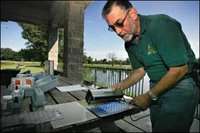Swimming Holes or Black Holes?
The Joplin Globe, Sunday, July 2, 2006, reports in a front page headline, that bacterial levels in area creeks, streams remain ambiguois. Mr. Frank Martinez, member of Carthage Stream Team No. 2416 is quoted as saying that bacteria monitoring at five Spring River sites, upstream and downstream of Carthage, has regularly picked up Escherichia (E.) coli and enterococci at levels that exceed standard defined as safe by the Environmental Protection Agency. Acording to federal standards, there should not be more than 126 colonies of E. coli and no more than 33 colonies of enterococci per 100 milliliters of water.
In April 2006, all five Carthage Spring River locations (Morrow Mill, Francis Street, Tucker's Ford, an unnamed tributary near Butterball, and Kellogg Lake) exceeded standards for one or both bacteria. Similiar numbers were found again in June. The Carthage Stream Team often has found what is called the most probable number: 2,419.6 for either E. coli or enterococci at one or more locations. Martinez said that the bacteria are so widespead that the team's equipment simply can't measure it.

The Joplin Globe/David Stonner
Carthage stream team sponsor Frank Martinez tests water clarity at Kellogg Lake.
The article includes E. coli sample levels taken from Indian Creek (April 11, May 25, June 6, and June 20, 2006); Spring River (June 2, June 11, June 17, and June 23, 2006); and Shoal Creek at Old Highway EE Bridge-Granby (April 11, May 25, and June 20, 2006); Lime Kiln Conservation area (May 25, June 6, and June 20, 2006); and Old Highway 71-Undercliff (May 25, June 6 and June 20, 2006). The Indian Creek samples exceded the safe levels each date. The Spring River samples exceded safe levels on June 2 and June 17, 2006. The Shoal Creek samples exceded the safe levels on April 11, May 25 and June 6, 2006. Mr Matinez said that "There is absolutely no misinterpretation of the data. It is freightening to think we have allowed this to happen to our rivers and streams."
The article also includes information on regional water sampling efforts. They are:
Ottawa County, OK. Environmental Health Officer, Preston Ross, said that there's a blanket advisory against swimming in the streams, rivers and lakes in Ottawa County, including upper Grand Lake, because of high levels of bacteria. "It's dangerous. Basically the swimming holes that are not chlorinated we recommend not to swim in".
Cherokee County, KS. Health Department Environmental Officer, Carl Hayes, said "When in doubt, stay out."
McDonald County, MO. officials do not have any information on bacteria levels.
Newton County, MO. Health Department Administrator, Bob Kulp, said that preliminary sampling done last year with interns monitoring 83 sites throughout the county, found 62% of all samples were at levels considered unsafe for swimming due to high levels of E. coli. Newton County also tested for ammonia, nitrates and phosphates.
Jasper County, MO. Health Department Administrator, Tony Moehr, said that "There is no specific statuatory authority to do anything. When you come right down to it, we have along line we are required to enforce."
Barry County, MO. Health Department Administrator, Kathleen King, said "I don't have the resources for it." She added that 'Education is what brings about change. Without that information we may never get the change."
Christian County, MO. Health Department Director, Karen Potter, commits a full-time staff person to one day a week in the summer to gather water samples at nine sites. "Our resources are stretched pretty thin but we do think water quality in the county is important."

0 Comments:
Post a Comment
<< Home